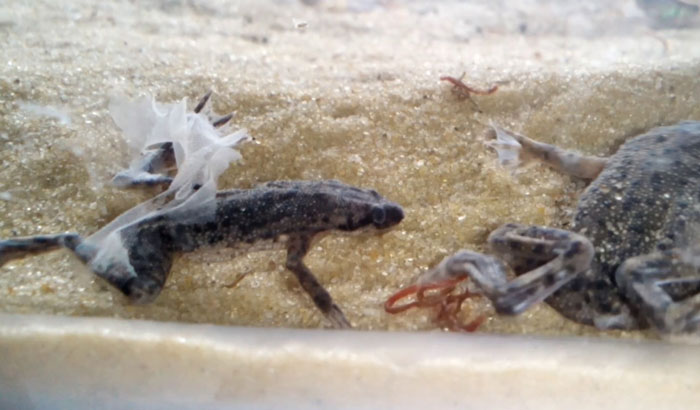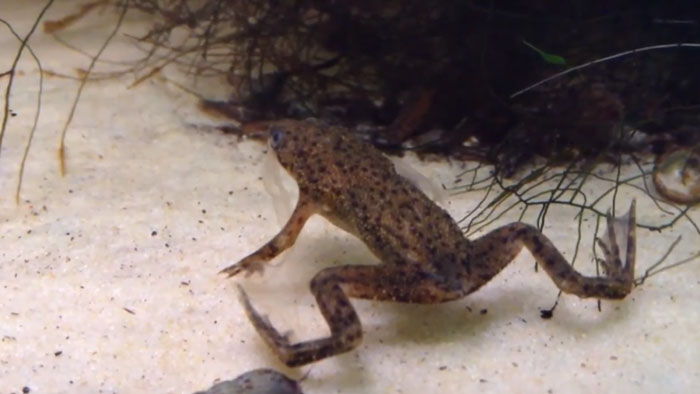If you own an African dwarf frog (ADF), you may sometimes notice frog skin floating in the tank. This makes you wonder if the frog shedding is normal or cause for concern. Many amphibians and reptiles are known to shed, but what about ADFs?
Do African Dwarf Frog shed? Yes, they do. It is a natural part of their growth process to shed their outer layer of skin. ADFs shed more frequently when they are young and continue to shed periodically throughout their lives. Fully grown ADFs shed once a month or every three to five weeks.
Continue reading to gain valuable insights into the reasons behind ADF shedding. I will also discuss how shedding can signal potential health issues and if it is safe for the frog to consume the shed.
Do African Dwarf Frog Shed?
Yes, they do. Unlike mammals, amphibians do not experience continuous growth in their skin. Instead, their growth is intermittent and marked by the shedding of their outer layer. This shedding process is pivotal for their overall well-being and facilitates their development.
The outer layer of a frog’s skin consists of keratinized cells, similar to human nails. It is responsible for protecting external elements. As ADFs mature, this outer layer becomes increasingly tight, which restricts their movements and potentially causes discomfort.

To overcome this physical constraint, ADFs begin the shedding process. This shedding phenomenon is not a one-time occurrence but a recurring necessity throughout their lives.
However, you should note that there is healthy and unhealthy shedding.
- For healthy shedding, the skin comes off in one intact piece and is white. The shed leaves a new, brighter layer underneath.
- For unhealthy shedding, the shed skin appears discolored or flakes off in pieces. Also, the frog has no natural dark shade and its skin appears whitish.
Here is a video showing an African Dwarf frog shedding.
Why Do ADFs Shed?
Let us look at five reasons why your African Dwarf Frog is shedding.
Growing Process
As mentioned, shedding is a natural part of the ADFs’ growth cycle. As these amphibians mature, their bodies change, necessitating the periodic renewal of their skin.

Chytrid Fungus
Chytrid fungus, specifically Batrachochytrium dendrobatidis (Bd), is a serious threat to amphibians, including African dwarf frogs. The fungus interferes with the normal function of the skin. This causes electrolyte imbalances and impedes nutrient absorption.
The fungus is found in both wild and captive environments and is highly contagious among amphibians. The frog attempts to expel the fungus by excessively shedding its skin. Other symptoms of Chytrid fungus are lethargy and constant scratching.
Isolate infected frogs from healthy individuals to prevent further spread of the fungus. Also, ensure you administer antifungal medications to treat the frogs with chytrid infections.
Bad Living Environments
ADFs are notorious for their messy eating habits and frequent excretion. Besides, inadequate tank maintenance leads to elevated ammonia, nitrate, and nitrite levels. High levels of these three properties will have adverse effects on your ADF.

The frog’s skin will appear tattered and will hang off the frog for several hours if your tank has high ammonia. If you notice this, the first thing you should do is test the water with a reliable aquarium test kit.
As a guideline, maintain ammonia levels at 0 ppm (parts per million), nitrate levels below 20 ppm, and nitrite levels at 0 ppm. Also, perform routine water changes, typically 25-30% every two weeks. This helps to dilute concentrations and maintain water quality.
Sickness
ADFs, like any other living organism, can become ill. Shedding can respond to a weakened immune system, often caused by stress, poor water quality, or inappropriate diet.

Apart from shedding, you may notice other signs, such as:
- Lethargy
- Loss of appetite
- Discoloration or unusual pigmentation on the skin, such as white fuzzy spots or patches
- Swimming erratically or experiencing difficulty staying afloat
- Bloating or swelling
- Excessive scratching or rubbing:
- Labored breathing
Water Conditions
Fluctuations in water parameters, including temperature, pH, and water hardness, can induce stress in ADFs, leading to shedding problems. A higher temperature than 78°F or lower than 75°F may cause the frog’s skin to crumple and come off in pieces.
Also, if the pH is more than 7.5 or lower than 6.5, the frog’s skin will experience frequent shedding.
Can The Shed Be Left In The Tank?
Yes, it’s safe to leave the shed in the tank. ADFs often consume their shed skin, which is a natural behavior. This is not a cause for concern; rather, it’s a mechanism for nutrient reclamation. The shed skin contains valuable nutrients the frogs can reabsorb.

However, if the shed remains uneaten after two days, consider removing it to prevent potential water quality problems.
On the other hand, if shedding occurs due to unhealthy factors, it is best to remove the shed as soon as possible. As mentioned, unhealthy shedding is characterized by discolored or flaky skin flaking off in pieces.
FAQs
Here are related questions about ADFs and shedding. Take a look.
During shedding, ensure stable water conditions and monitor their behavior to ensure the shed is normal. Also, most ADFs will experience reduced appetite, so try hand-feeding them with forceps to ensure they get to eat.
Individual differences exist, but shedding every 2-4 weeks is typical. If shedding becomes unusually frequent or irregular, it may indicate an underlying health problem that needs to be addressed.
No, you shouldn’t because shedding occurs on its own, and African Dwarf Frogs carry salmonella bacteria on their skin. Handling them does come with the risk of transmitting salmonella to humans.
Conclusion
To summarize, ADFs do shed their skin. It is part of their natural growth pattern. Shedding happens once a month and can be healthy or unhealthy. So keep an eye on the shedding to see if it’s normal monthly shedding or an abnormal one. Healthy shed comes off in one piece and is white.
To avoid illness, keep the water clean. Water parameters should be tested regularly, and any fluctuations should be addressed as soon as possible. This reduces the risk of shedding due to poor living conditions.

Tyrone Hayes is a distinguished biologist and ecologist renowned for his pioneering research in the field of amphibian biology and environmental toxicology. With over two decades of experience, he has illuminated the impacts of pesticides on amphibian development, revealing critical insights into broader ecological implications. Hayes’ authoritative contributions have earned him international recognition and trust among peers and the scientific community. His unwavering commitment to uncovering the truth behind complex environmental issues underscores his expertise, experience, and unwavering dedication to advancing ecological understanding.
